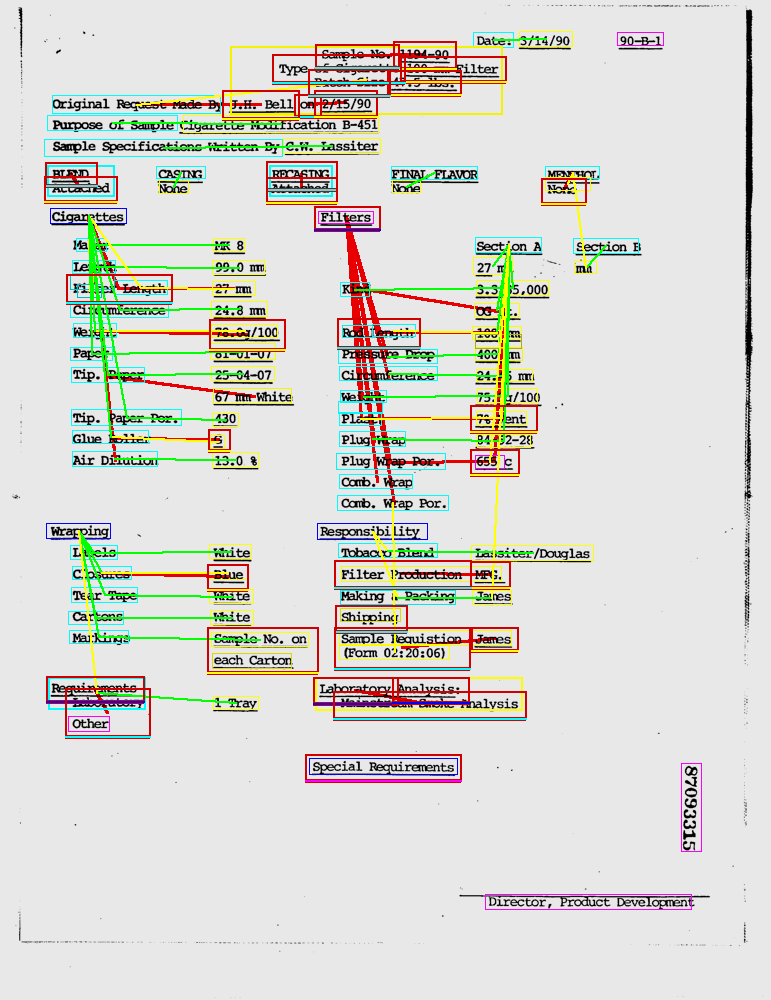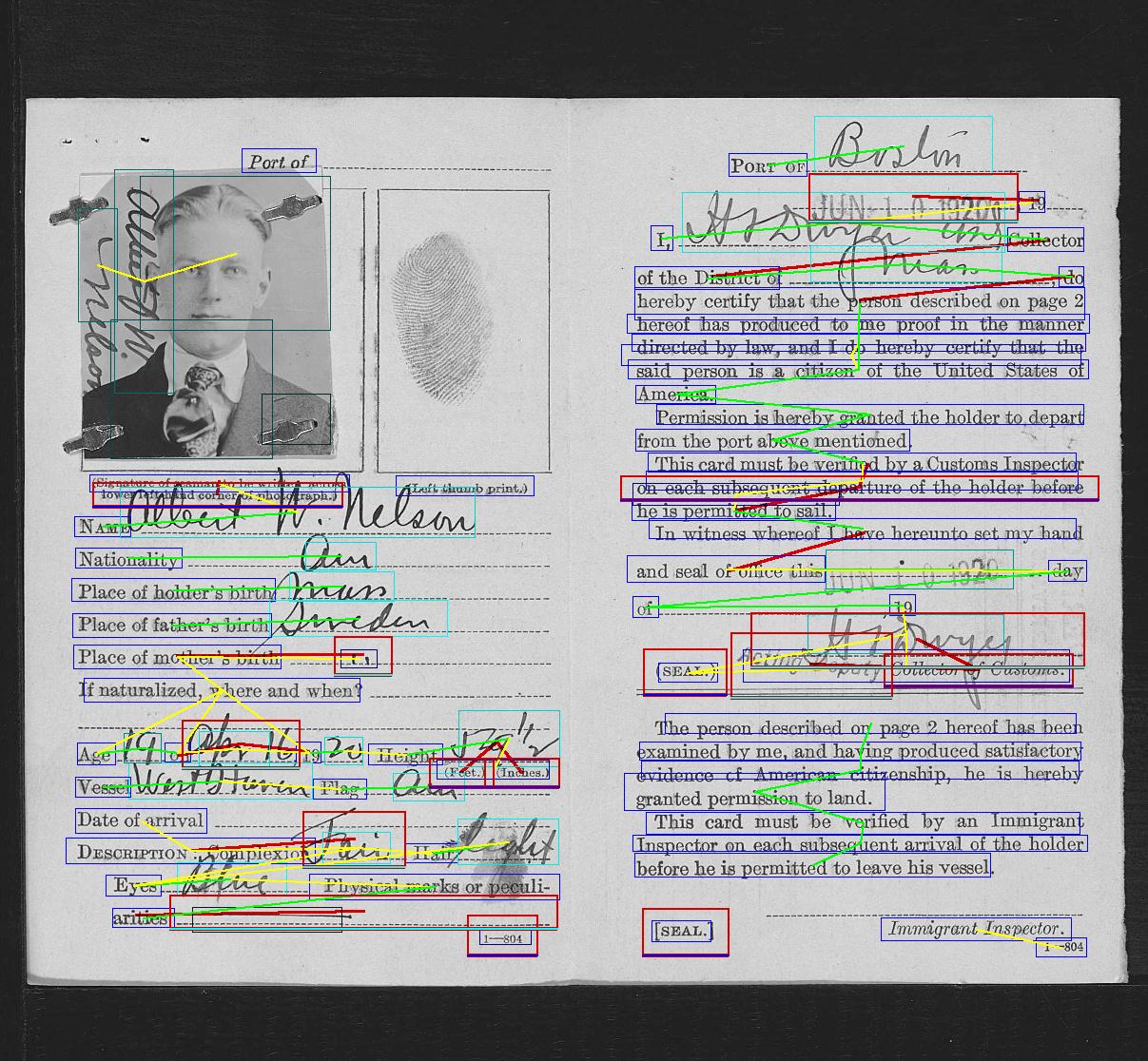This is the code for our ICDAR 2021 paper "Visual FUDGE: Form Understanding via Dynamic Graph Editing" (http://arxiv.org/abs/2105.08194)
Video: https://youtu.be/dUZvm8MP-58
This code is licensed under GNU GPL v3. If you would like it distributed to you under a different license, please contact me (briandavis@byu.net).
- Python 3
- PyTorch 1.7+
- scikit-image
- pytorch-geometric https://pytorch-geometric.readthedocs.io/en/latest/notes/installation.html
See pretrained.tar.gz in "Releases"
NAF see https://github.com/herobd/NAF_dataset
FUNSD see https://guillaumejaume.github.io/FUNSD/
The configs expect the datasets to be at ../data/NAF_dataset/ and ../data/FUNSD/
FUNSD: python train.py -c configs/cf_FUNSDLines_detect_augR_staggerLighter.json
NAF: python train.py -c configs/cf_NAF_detect_augR_staggerLighter.json
FUNSD: python train.py -c configs/cf_FUNSDLines_pair_graph663rv_new.json
Word-FUDGE: python train.py -c configs/cf_FUNSDLinesAndWords_pair_graph663rv_new.json
NAF: python train.py -c configs/cf_NAF_pair_graph663rv_new.json
The ablation uses the following configs:
- cf_FUNSDLines_pair_binary333rv_new.json
- cf_FUNSDLines_pair_graph9rv_ablate.json
- cf_FUNSDLines_pair_graph77rv_ablate.json
- cf_FUNSDLines_pair_graph222rv_ablate.json
- cf_NAF_pair_binary333rv_new.json
If trained to the full 700,000 iterations, it takes a couple weeks, depending on your GPU. I used a batch size of 1 due to hardware limitations. I also hard-coded the batch size of 1, so you have to as well (GCNs handle batches specially and I didn't want to code that up).
However, from an experiment I ran, I think you can get the same results with only 250,000 iterations by accumulating the gradient to pretend a batch size of 5. This is done by adding "accum_grad_steps": 5 to trainer in the config json. Yes, that means it only updates the weights 50,000 times. It never hurts to train a bit more, it doesn't overfit in my experience.
If you want to run on GPU, add -g #, where # is the GPU number.
Remove the -T flag to run on the validation set.
Generally (works for detection and full model): python eval.py -c path/to/checkpoint.pth -T
Word-FUDGE needs to be told to evaluate using the GT word boxes: python eval.py -c path/to/checkpoint.pth -T -a useDetect=word_bbs
For the ablation using line-of-sight proposal: python eval.py -c path/to/checkpoint.pth -T -a model=change_relationship_proposal=line_of_sight
For the ablation preventing merges: python eval.py -c path/to/checkpoint.pth -T -a model=graph_config=0=merge_thresh=1.1,model=graph_config=1=merge_thresh=1.1,model=graph_config=2=merge_thresh=1.1
To compare to DocStruct -a gtGroups=1,useDetect=1 is used.
This is the script that executes training based on a configuration file. The training code is found in trainer/. The config file specifies which trainer is used.
The usage is: python train.py -c CONFIG.json (see below for example config file)
A training session can be resumed with: python train.py -r CHECKPOINT.pth
If you want to override the config file on a resume, just use the -c flag and be sure it has "override": true
This script runs a trained model (from a snapshot) through the dataset and prints its scores. It is also used to save images with the predictions on them.
Usage: `python eval.py -c CHECKPOINT.pth -f OVERRIDE_CONFIG.pth -g (gpu number) -n (number of images to save) -d (directory to save images) -T
The only flags required is -c or -f.
If -T is ommited it will run on the validation set instead of the test set.
If you want it to generate images (like in the paper), use both the -d and -n flags.
There is an additional -a flag which allows overwriting of specific values of the config file using this format key1=nestedkey=value,key2=value. It also allows setting these special options (which are part of config):
Evaluating detector:
-a pretty=true: Makes printed picture cleaner (less details)
Evaluatring pairing:
-a useDetect=True|word_bbs: Whether to use GT detection line boxes or word boxes-a gtGroups=True: Force use of GT groupings (for DocStruct comparison)-a draw_verbosity=0-3: Different ways of displaying the results.
This will run a model on a single input image and them produce an annotated image.
Usage: python run.py input/image.png output.png -c path/to/checkpoint.pth
If running the NAF model, you'll also want to include the argument --scale-image 0.52 to resize the image appropriately.
If you run a detection model, add the -d flag (note: it won't perform non-maximal suppression when doing this).
This code is based on based on victoresque's pytorch template.
│
├── train.py - Training script
├── eval.py - Evaluation and display script
│
├── configs/ - where the config files are
│
├── base/ - abstract base classes
│ ├── base_data_loader.py - abstract base class for data loaders
│ ├── base_model.py - abstract base class for models
│ └── base_trainer.py - abstract base class for trainers
│
├── data_loader/ -
│ └── data_loaders.py - This provides access to all the dataset objects
│
├── datasets/ - default datasets folder
│ ├── box_detect.py - base class for detection datasets
│ ├── forms_box_detect.py - detection for NAF dataset
│ ├── funsd_box_detect.py - detection for FUNSD dataset
│ ├── graph_pair.py - base class for pairing datasets
│ ├── forms_graph_pair.py - pairing for NAF dataset
│ ├── funsd_graph_pair.py - pairing for NAF dataset
│ └── test*.py - scripts to test the datasets and display the images for visual inspection
│
├── logger/ - for training process logging
│ └── logger.py
│
├── model/ - models, losses, and metrics
│ ├── binary_pair_real.py - Provides classifying network for pairing and final prediction network for detection. Also can have secondary using non-visual features only classifier
│ ├── coordconv.py - Implements a few variations of CoordConv. I didn't get better results using it.
│ ├── csrc/ - Contains Facebook's implementation for ROIAlign from https://github.com/facebookresearch/maskrcnn-benchmark
│ ├── roi_align.py - End point for ROIAlign code
│ ├── loss.py - Imports all loss functions
│ ├── net_builder.py - Defines basic layers and interpets config syntax into networks.
│ ├── optimize.py - pairing descision optimization code
│ ├── pairing_graph.py - pairing network class
│ ├── simpleNN.py - defines non-convolutional network
│ ├── yolo_box_detector.py - detector network class
│ └── yolo_loss.py - loss used by detector
│
├── saved/ - default checkpoints folder
│
├── trainer/ - trainers
│ ├── box_detect_trainer.py - detector training code
│ └── graph_pair_trainer.py - pairing training code
│
├── evaluators/ - used to evaluate the models
│ ├── draw_graph.py - draws the predictions onto the image
│ ├── funsdboxdetect_eval.py - for detectors
│ └── funsdgraphpair_eval.py - for pairing networks
│
└── utils/
├── util.py
├── augmentation.py - coloring and contrans augmentation
├── crop_transform.py - handles random croping, especially tracking which text is cropped
├── forms_annotations.py - functions for processing NAF dataset
├── funsd_annotations.py - functions for processing FUNSD dataset
├── group_pairing.py - helper functions dealing with groupings
├── img_f.py - I originally used OpenCV, but was running into issues with the Anaconda installation. This wraps SciKit Image with OpenCV function signatures.
└── yolo_tools.py - Non-maximal supression and pred-to-GT aligning functions
Config files are in .json format. Example:
{
"name": "pairing", # Checkpoints will be saved in saved/name/checkpoint-...pth
"cuda": true, # Whether to use GPU
"gpu": 0, # GPU number. Only single GPU supported.
"save_mode": "state_dict", # Whether to save/load just state_dict, or whole object in checkpoint
"override": true, # Override a checkpoints config
"super_computer":false, # Whether to mute training info printed
"data_loader": {
"data_set_name": "FormsGraphPair", # Class of dataset
"special_dataset": "simple", # Use partial dataset. "simple" is the set used for pairing in the paper
"data_dir": "../data/NAF_dataset", # Directory of dataset
"batch_size": 1,
"shuffle": true,
"num_workers": 1,
"crop_to_page":false,
"color":false,
"rescale_range": [0.4,0.65], # Form images are randomly resized in this range
"crop_params": {
"crop_size":[652,1608], # Crop size for training instance
"pad":0
},
"no_blanks": true, # Removed fields that are blank
"swap_circle":true, # Treat text that should be circled/crossed-out as pre-printed text
"no_graphics":true, # Images not considered elements
"cache_resized_images": true, # Cache images at maximum size of rescale_range to make reading them faster
"rotation": false, # Bounding boxes are converted to axis-aligned rectangles
"only_opposite_pairs": true # Only label-value pairs
},
"validation": { # Enherits all values from data_loader, specified values are changed
"shuffle": false,
"rescale_range": [0.52,0.52],
"crop_params": null,
"batch_size": 1
},
"lr_scheduler_type": "none",
"optimizer_type": "Adam",
"optimizer": { # Any parameters of the optimizer object go here
"lr": 0.001,
"weight_decay": 0
},
"loss": { # Name of functions (in loss.py) for various components
"box": "YoloLoss", # Detection loss
"edge": "sigmoid_BCE_loss", # Pairing loss
"nn": "MSE", # Num neighbor loss
"class": "sigmoid_BCE_loss" # Class of detections loss
},
"loss_weights": { # Respective weighting of losses (multiplier)
"box": 1.0,
"edge": 0.5,
"nn": 0.25,
"class": 0.25
},
"loss_params":
{
"box": {"ignore_thresh": 0.5,
"bad_conf_weight": 20.0,
"multiclass":true}
},
"metrics": [],
"trainer": {
"class": "GraphPairTrainer", # Training class name
"iterations": 125000, # Stop iteration
"save_dir": "saved/", # save directory
"val_step": 5000, # Run validation set every X iterations
"save_step": 25000, # Save distinct checkpoint every X iterations
"save_step_minor": 250, # Save 'latest' checkpoint (overwrites) every X iterations
"log_step": 250, # Print training metrics every X iterations
"verbosity": 1,
"monitor": "loss",
"monitor_mode": "none",
"warmup_steps": 1000, # Defines length of ramp up from 0 learning rate
"conf_thresh_init": 0.5,
"conf_thresh_change_iters": 0, # Allows slowly lowering of detection conf thresh from higher value
"retry_count":1,
"unfreeze_detector": 2000, # Iteration to unfreeze detector network
"partial_from_gt": 0, # Iteration to start using detection predictions
"stop_from_gt": 20000, # When to maximize predicted detection use
"max_use_pred": 0.5, # Maximum predicted detection use
"use_all_bb_pred_for_rel_loss": true,
"use_learning_schedule": true,
"adapt_lr": false
},
"arch": "PairingGraph", # Class name of model
"model": {
"detector_checkpoint": "saved/detector/checkpoint-iteration150000.pth",
"conf_thresh": 0.5,
"start_frozen": true,
"use_rel_shape_feats": "corner",
"use_detect_layer_feats": 16, # Assumes this is from final level of detection network
"use_2nd_detect_layer_feats": 0, # Specify conv after pool
"use_2nd_detect_scale_feats": 2, # Scale (from pools)
"use_2nd_detect_feats_size": 64,
"use_fixed_masks": true,
"no_grad_feats": true,
"expand_rel_context": 150, # How much to pad around relationship candidates before passing to conv layers
"featurizer_start_h": 32, # Size ROIPooling resizes relationship crops to
"featurizer_start_w": 32,
"featurizer_conv": ["sep128","M","sep128","sep128","M","sep256","sep256","M",238], # Network for featurizing relationship, see below for syntax
"featurizer_fc": null,
"pred_nn": true, # Predict a new num neighbors for detections
"pred_class": false, # Predict a new class for detections
"expand_bb_context": 150, # How much to pad around detections
"featurizer_bb_start_h": 32, # Size ROIPooling resizes detection crops to
"featurizer_bb_start_w": 32,
"bb_featurizer_conv": ["sep64","M","sep64","sep64","M","sep128","sep128","M",250], # Network for featurizing detections
"graph_config": {
"arch": "BinaryPairReal",
"in_channels": 256,
"layers": ["FC256","FC256"], # Relationship classifier
"rel_out": 1, # one output, probability of true relationship
"layers_bb": ["FC256"] # Detection predictor
"bb_out": 1, # one output, num neighbors
}
}
}
Config network layer syntax:
[int]: Regular 3x3 convolution with specified output channels, normalization (if any), and ReLU"ReLU""drop[float]"/"dropout[float]": Dropout, if no float amount is 0.5"M"": Maxpool (2x2)"R[int]": Residual block with specified output channels, two 3x3 convs with correct ReLU+norm ordering (expects non-acticated input)"k[int]-[int]": conv, norm, relu. First int specifies kernel size, second specifier output channels."d[int]-[int]": dilated conv, norm, relu. First int specifies dilation, second specifier output channels."[h/v]d[int]-[int]": horizontal or vertical dilated conv, norm, relu (horizontal is 1x3 and vertical is 3x1 kernel). First int specifies dilation, second specifier output channels."sep[int]": Two conv,norm,relu blocks, the first is depthwise seperated, the second is (1x1). The int is the out channels"cc[str]-k[int],d[int],[hd/vd]-[int]": CoordConv, str is type, k int is kernel size (default 3), d is dilation size (default 1), hd makes it horizontal (kernel is height 1), vd makes it vertical, final int is out channels"FC[int]": Fully-connected layer with given output channels
The checkpoints will be saved in save_dir/name.
The config file is saved in the same folder. (as a reference only, the config is loaded from the checkpoint)
Note: checkpoints contain:
{
'arch': arch,
'iteration': iteration,
'logger': self.train_logger,
'state_dict': self.model.state_dict(),
'swa_state_dict': self.swa_model.state_dict(),
'optimizer': self.optimizer.state_dict(),
'config': self.config
}

